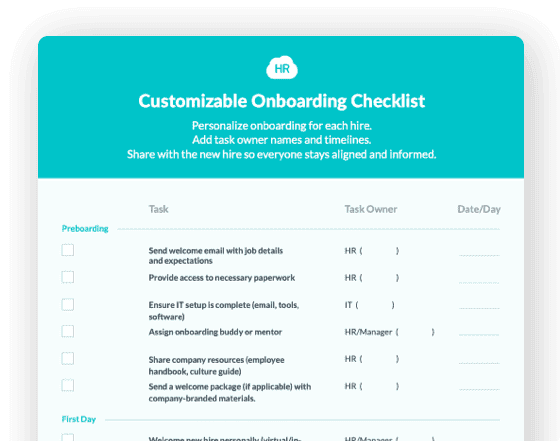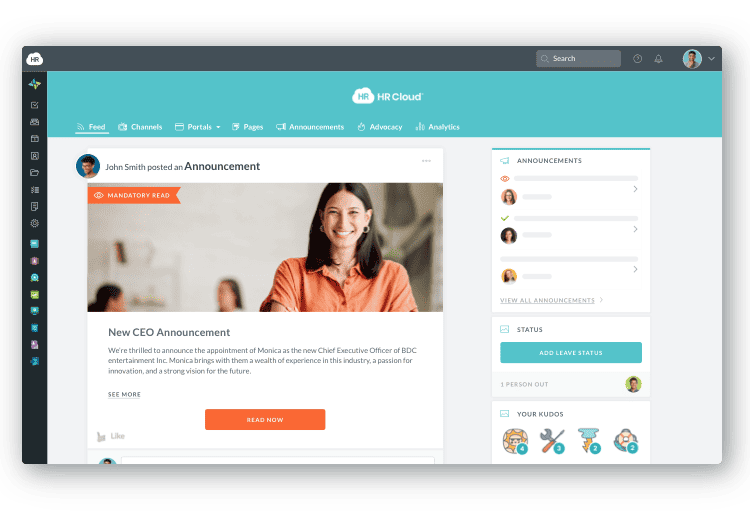Biweekly Check: A Strategic Approach to Continuous Performance Management
- What Makes Biweekly Checks Work for Modern Teams
- Biweekly Checks vs. Other Performance Conversation Models
- How to Run Biweekly Checks That Actually Drive Results
- Common Mistakes That Undermine Biweekly Checks
- Biweekly Checks Across Different Work Environments
- Getting Started with Biweekly Performance Conversations
- The Evolution of Performance Check-Ins

 Cut onboarding time
by 60%—here's the
Ultimate Checklist
that helped do it.
Cut onboarding time
by 60%—here's the
Ultimate Checklist
that helped do it.

A biweekly check is a scheduled conversation between a manager and employee that happens every two weeks to discuss progress, address challenges, provide feedback, and align on goals. These regular touchpoints replace the outdated annual review model with ongoing dialogue that keeps performance management relevant and actionable. Research shows that organizations implementing continuous feedback mechanisms see higher engagement and 14.9% lower turnover rates compared to those relying solely on yearly evaluations.
Unlike traditional performance reviews that feel like high stakes judgments, biweekly checks create space for genuine coaching conversations. They give managers the chance to remove roadblocks in real time while helping employees course correct before small issues become major problems. When employee check-ins happen consistently, they transform the manager's role from evaluator to coach and mentor.
The shift toward more frequent performance conversations reflects what employees actually want. According to industry research, 81% of employees feel they should receive feedback at least quarterly, with many preferring even more frequent touchpoints. Biweekly checks strike a practical balance between staying connected and avoiding meeting fatigue. These conversations provide the feedback frequency employees crave while remaining manageable for busy managers.
What Makes Biweekly Checks Work for Modern Teams
Biweekly checks succeed because they align with how work actually gets done today. Projects move faster, priorities shift quickly, and waiting a year to discuss performance simply does not work anymore. Here are the core elements that make biweekly checks effective:
Regular Rhythm Builds Trust:
Meeting every two weeks creates predictability. Employees know they will have dedicated time with their manager, which reduces anxiety and builds stronger working relationships.
Problems Get Solved Faster:
When you catch issues early, you can fix them before they derail projects or damage morale. Small course corrections prevent major failures.
Feedback Stays Relevant:
Discussing work that happened last week feels meaningful. Talking about something from six months ago feels pointless. Biweekly timing keeps conversations fresh.
Development Happens Continuously:
Rather than setting goals once a year and hoping for the best, managers can adjust development plans based on what employees actually need right now.
Recognition Becomes Timely:
When great work gets acknowledged within days instead of months, it reinforces the behaviors you want to see more often.
Data Informs Decisions:
Regular check-ins generate consistent performance data that helps with succession planning, compensation decisions, and identifying high potential talent through your performance management software.
Biweekly Checks vs. Other Performance Conversation Models
|
Approach |
Frequency |
Best For |
Key Limitations |
|
Biweekly Checks |
Every 2 weeks |
Balanced continuous feedback, standard projects, team alignment |
Requires consistent manager commitment |
|
Weekly Check-ins |
Every week |
Fast-paced environments, new employees, critical projects |
Can feel excessive for experienced staff |
|
Monthly Reviews |
Monthly |
Established teams, longer project cycles, limited manager capacity |
May miss emerging issues |
|
Quarterly Reviews |
Every 3 months |
Senior roles, strategic initiatives, supplement to informal feedback |
Too infrequent for real-time course correction |
|
Annual Reviews |
Once yearly |
Formal documentation only, not as primary feedback tool |
Outdated, demotivating, misses opportunities |
How to Run Biweekly Checks That Actually Drive Results
Getting value from biweekly checks requires more than just putting meetings on the calendar. Both managers and employees need to show up prepared and engaged. Consider these practical approaches:
Set a consistent schedule and protect that time. Canceling check-ins sends the message that performance conversations do not matter. Block the time, respect it, and make attendance non-negotiable unless true emergencies arise.
Come prepared with specific examples. Vague feedback like "you need to communicate better" helps no one. Instead, reference actual situations from the past two weeks where communication worked well or fell short. Specificity makes feedback actionable.
Balance forward and backward looking topics. Spend time discussing what happened since your last check-in, but dedicate equal energy to what comes next. Goal progress, upcoming challenges, and needed resources should all get airtime during these employee engagement conversations.
Document key takeaways and commitments. Memory fades quickly. Write down action items, decisions, and important points raised. This documentation creates accountability and provides helpful context for future conversations.
Create psychological safety. Gallup research shows that employees who receive meaningful feedback are significantly more likely to be engaged. Meaningful feedback only happens when employees feel safe being honest about struggles, mistakes, and concerns.
Adjust your approach based on individual needs. New hires need different conversations than veteran employees. High performers want different topics than those working through performance issues. Flexibility within your biweekly structure shows you see employees as individuals.


Common Mistakes That Undermine Biweekly Checks
Even with good intentions, managers often stumble when implementing biweekly checks. Awareness of these pitfalls helps you avoid them from the start.
Treating them like status updates wastes everyone's time. If the entire conversation focuses on project updates that could have been shared via email, you have missed the point. Biweekly checks should dig deeper into challenges, development, and relationship building.
Talking instead of listening defeats the purpose. Managers who dominate airtime turn check-ins into lectures rather than conversations. According to SHRM research on effective performance management, the best discussions happen when employees do most of the talking.
Skipping documentation creates problems later. When nothing gets written down, commitments get forgotten and patterns become invisible. You need documentation to track themes over time and support formal reviews when they happen.
Focusing only on problems demoralizes people. Yes, biweekly checks should address issues, but they must also celebrate wins and acknowledge effort. Research confirms that teams receiving strengths-based feedback show 12.5% higher productivity.
Lacking structure leads to rambling conversations. While flexibility matters, having a consistent framework helps ensure you cover important ground. Create a simple template that guides discussions without making them feel rigid or formulaic.
Biweekly Checks Across Different Work Environments
The beauty of biweekly checks lies in their adaptability. Different industries and work settings benefit from this cadence while customizing the approach to their specific needs.
In technology companies, where priorities shift rapidly and projects move in quick sprints, biweekly checks align perfectly with agile methodologies. Software teams already meeting for sprint planning and retrospectives find that biweekly one-on-one conversations complement their existing rhythms. These discussions help engineers discuss technical challenges, career growth, and cross-team collaboration away from the pressure of delivery deadlines.
Healthcare organizations use biweekly checks to support frontline staff facing high stress environments. Nurses, physicians, and support staff benefit from regular touchpoints that acknowledge the emotional toll of patient care while providing practical support. These conversations become spaces to discuss workload management, continuing education, and workplace wellbeing. Integrating biweekly checks with broader employee engagement strategies helps healthcare teams stay resilient.
Retail environments adapt biweekly checks to accommodate shift work and seasonal fluctuations. Store managers schedule brief but focused conversations with team leads and associates to discuss sales goals, customer feedback, and scheduling needs. The regular cadence helps identify training opportunities and recognize strong performance during busy periods when formal recognition might otherwise get overlooked.
Getting Started with Biweekly Performance Conversations
Launching biweekly checks across your organization requires thoughtful planning and clear communication. Follow these steps to build a sustainable practice:
Step 1:
Gain leadership commitment. Senior leaders need to model the behavior and provide managers with time to conduct quality check-ins. Without executive sponsorship, the initiative will fail.
Step 2:
Define your framework. Create a simple structure that guides conversations without constraining them. Include prompts for discussing goal progress, challenges, wins, development needs, and upcoming priorities. Share this framework with all managers and employees so everyone knows what to expect.
Step 3:
Train managers on coaching skills. Most managers never receive formal training on giving feedback or conducting developmental conversations. Invest in building these capabilities before rolling out biweekly checks. Strong performance management practices depend on manager competence.
Step 4:
Implement gradually. Start with a pilot group of teams before expanding organization wide. Gather feedback from the pilot, refine your approach, and then scale. Rushing implementation creates resistance and poor execution.
Step 5:
Provide enabling technology. Manual scheduling and documentation creates unnecessary friction. Select tools that make it easy to schedule recurring meetings, store notes securely, and track commitments over time. The right employee performance management platform streamlines administration so managers can focus on conversations.
Step 6:
Measure impact and iterate. Track participation rates, employee satisfaction with check-ins, and performance outcomes. Use this data to continuously improve your approach. What works in month one might need adjustment by month six as you learn what resonates with your teams.
The Evolution of Performance Check-Ins
Biweekly checks represent today's approach, but performance management continues evolving. Forward thinking organizations are already experimenting with what comes next.
Artificial intelligence will likely play a growing role in supporting these conversations. Imagine tools that analyze communication patterns, project data, and engagement signals to surface relevant topics for your next check-in. Rather than replacing human connection, AI could make conversations more focused and productive by handling the prep work.
Peer feedback integration will expand beyond traditional 360 reviews. The future likely includes lightweight, ongoing input from colleagues that managers can reference during biweekly conversations. This broader perspective helps employees see their impact across the organization, not just through their manager's lens.
Skills development will become more central to check-in discussions as careers grow less linear. Rather than climbing a single ladder, employees build portfolios of capabilities that open different opportunities. Biweekly checks will increasingly focus on identifying skill gaps and connecting people with learning resources in real time through integrated goal tracking software.
Remote and hybrid work patterns will continue shaping how check-ins happen. While video calls work well, organizations are exploring asynchronous options that respect different time zones and work styles. The key remains consistency and meaningful dialogue, regardless of the medium.
The organizations that thrive will be those that maintain the human connection at the core of biweekly checks while leveraging technology to make these conversations richer and more impactful. Your investment in building a strong check-in culture today positions you to adapt to whatever innovations emerge tomorrow. When you commit to regular, meaningful performance conversations, you create the foundation for sustained employee engagement, development, and organizational success.
Keep Reading
How HR Cloud Is Shaping the Future of HR in Senior Care
At the 2025 LeadingAge Annual Meeting in Boston, one conversation is taking centerstage —
Top 10 Best Employee Engagement Software
An employee engagement platform acts as a hub for the daily or other periodic rituals of
How to Improve Employee Engagement in Healthcare: 9 Simple Things to Start Doing Today
Improving employee engagement in healthcare teams directly impacts the level of care
Ready to streamline your onboarding process?
Book a demo today and see how HR Cloud can help you create an exceptional experience for your new employees.

